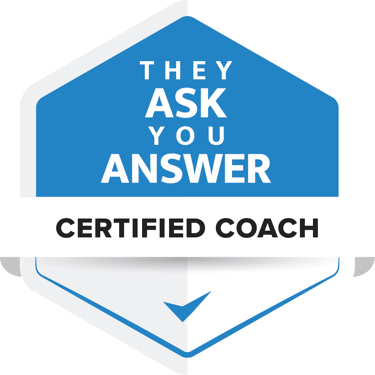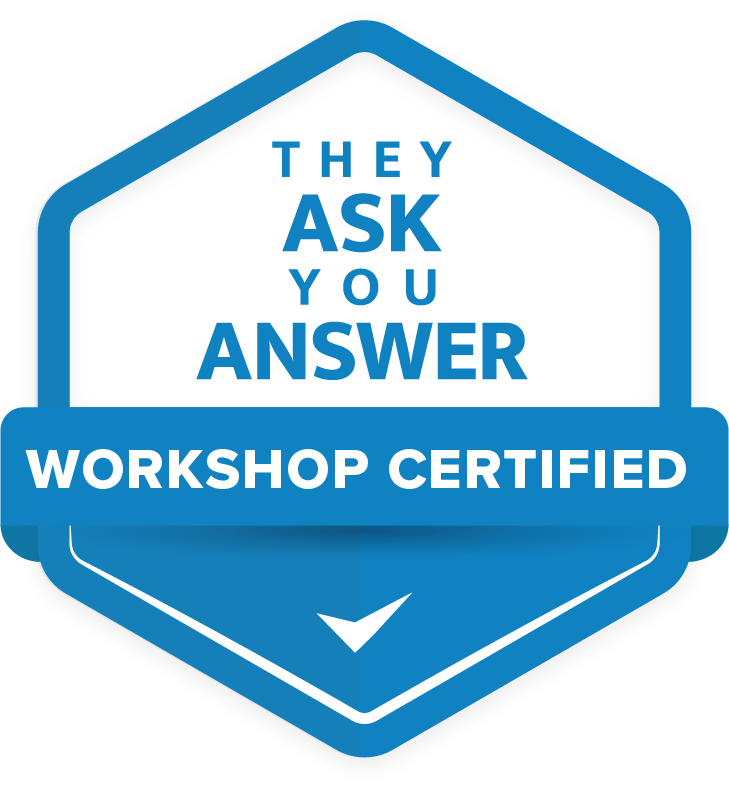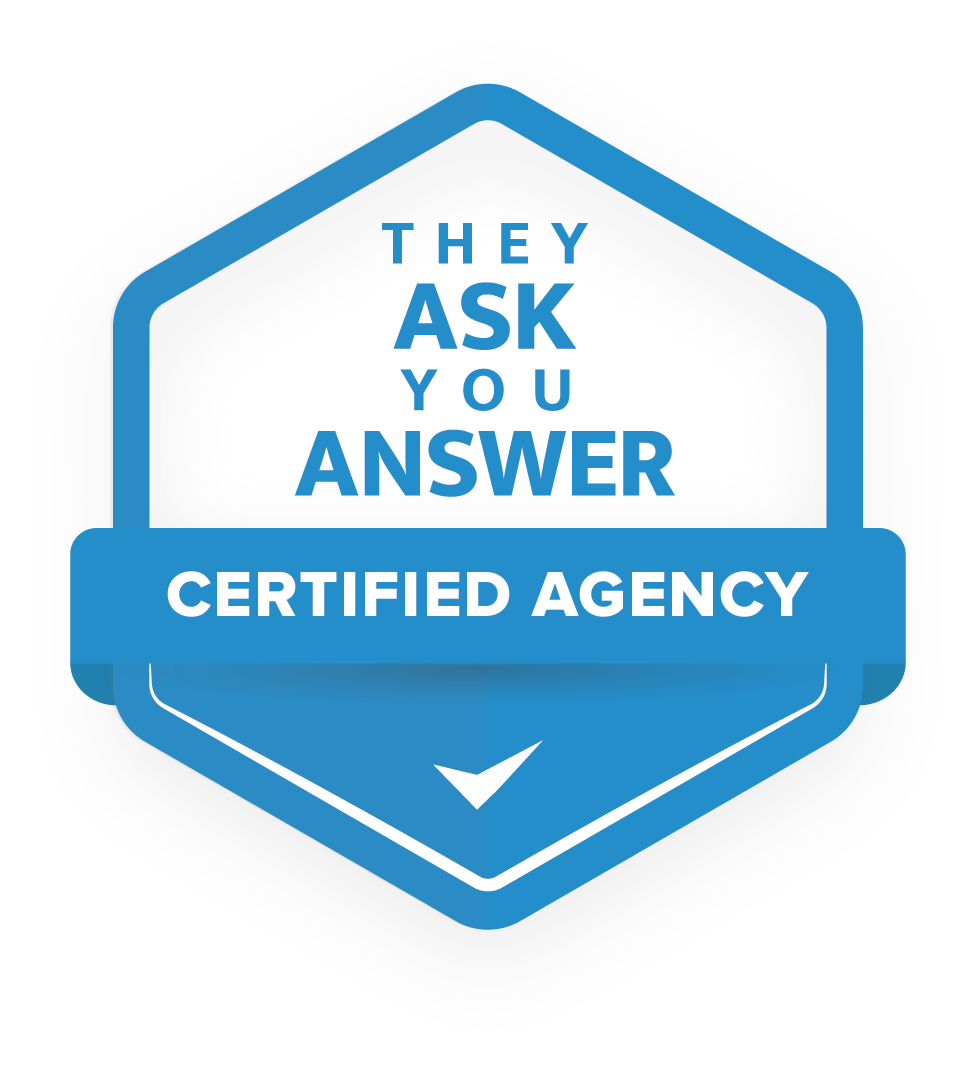Demand gen vs. TAYA: here's how to choose the right method for your organization

As a business owner or marketing manager, you know how crucial it is to choose the right marketing strategy. You read about demand generation (demand gen) on LinkedIn, you already work with it, or you're considering starting it.
But you also hear about They Ask, You Answer (TAYA) and wonder:
- So what exactly are the differences between demand gen and TAYA?
- Can I combine these two approaches?
- And what approach is best for my business?
You can contrast demand gen with TAYA and come to the conclusion that you need both for a healthy organization (as you can read in this article). But that doesn't do justice to demand gen.
I have been following both methods or "movements" for quite a few years and in my opinion there is a lot of overlap between them. But at the same time, I also see clear differences.
Especially for this article, I dove deep into demand gen and so I have been reading and listening to a lot about this approach recently.
In this article, I will discuss demand gen and TAYA in detail and the similarities and differences between the two methods. After reading this article, you will have a clear picture of both marketing strategies and will be able to make an informed choice: will you go for demand gen, will you go for TAYA or will you go for a combination?
Demand generation aims to create interest and demand for your products or services.
What is demand gene?
To start with definitions: what ís demand gene anyway?
Demand generation, often abbreviated to demand gen as I do in this article, is a marketing strategy that aims to create interest and demand for your products or services.
In my search for this article, I discovered that demand generation has no clear "founder story. There is not one book, one author, or one clear source that contains the answers to the questions I ask in this article.
What I have also noticed is the large amount of jargon that is difficult to translate into Dutch. In this article I will try to explain all the terms as much as possible.
So although there is no "single source of truth" regarding demand gen, there are some individuals and companies and businesses that I follow in the Netherlands and America. If you want to delve further into deman gen, I recommend following these individuals as well:
- Chris Walker (USA)
- Aldo Wink (NL)
- Edwin Vlems (NL)
You can also do this free course on demand gen from Cognism (USA).
The three basic principles of demand gen
Based on my research, I come up with three basic principles of demand generation. These have to do with the focus in the buying process, how companies that do demand gen gather leads or customers, and why they don't automate this process.
Basic Principle 1: Strong focus on reach before the search for a solution begins ("Out-Market")
Demand gen, the name says it all, is based on creating new demand. And for good reason: Professor John Dawes of the Ehrenberg-Bass Institute says that 95% of buyers in a category are Out-Market at any given time. This means they are not yet actively preparing a purchase. Your company's growth potential lies with its future customers (the 95%) and the cash flows they will generate.
Now of course we should focus our lead generation efforts on the 5% who are In-Market and capture their latent demand, but the problem in the B2B industry right now is that we focus almost exclusively on that 5% - so we miss out on 95% of prospective buyers.
We are still not making sure enough that they remember our companies so that we are the brands they think of when they do In-Market. This focus on Out-Market results in tactics aimed at building a strong brand.
How this component is set up (tactically) varies within the demand gen movement.
Tactics that are common are:
- value-driven organic posts (not designed to get clicks through, but to get engagement on LinkedIn);
- LinkedIn campaigns for specific audiences (for example, by presenting the IT manager with a different post than the company's CMO);
- Organic content distribution, turning a single (online) event into a podcast, video snippets, on-demand videos, a resources hub, blog posts, and social media posts.
These various tactics are difficult to distinguish from other methods, such as They Ask, You Answer.
Demand gen targets the 95% of buyers that are Out-Market.
Basic Principle 2: Lead generation, e-books behind forms, and gated content are a thing of the past
Internet users are filling out fewer and fewer forms on Web sites. Together, we have become much more distrustful. Is the content that is promised really informative and of value? Or do I get another meager PDF containing mostly sales information?
And what happens to my data? Will I end up in an automatic (spam) newsletter? And what can I expect after I fill out the form?
As a result, marketers are seeing less and less success with "gated content" (= content hidden behind a form), "email blasts" (= mass emails to a database), or other "demand capture" (= email collection) techniques.
The question, of course, is whether someone who downloaded your e-book, opened an e-mail, and signed up for your newsletter actually intends to buy from you.
You don't see the real intent until someone makes a so-called handraising request, such as filling out a demo or contact form.
High Intent Leads vs. Low Intent Leads
In a nutshell, two types of leads can be distinguished within demand gen, each representing a different value:
High Intent Leads
These are contacts who fill out a demo or contact form. By doing so, they show their intent to investigate your product/service. They ask for more information, and would like to speak to someone on your team. As I'm sure you can imagine, these leads convert faster into deals.
Low Intent Leads
These are contacts who fill out a random form, such as a form for an e-book or webinar. By doing so, they show interest in the topic, but this does not equate to an intention to research your product/service. Perhaps they are (still) generally looking for information.
Often these leads are not yet ready for personal interaction and are not yet waiting for emails or messages from a salesperson (and certainly not phone calls!). As you can imagine, these leads sit in your "pipeline" much longer (because they are still at the beginning of their buying process) and are less likely to convert to deals.
Within the demand gen movement, there is a "radical" movement that places no content behind forms at all and thus no longer collects Low Intent Leads.
There is also a somewhat more moderate current that uses a mix of both components, using a form only for very valuable content (think, for example, an extensive research report or a webinar).
Leads can be High Intent or Low Intent. Both represent a different value.
Basic principle 3: Lead scoring and nurturing emails are obsolete
Many marketing strategies are built around collecting leads. These are then "scored" based on, for example, their behavior on the website, sent (automated) emails that are again based on previous behavior (for example, clicking or not clicking in an email), and shared with sales.
This creates a mathematical model that looks like this, for example:
- 20,000 website visitors, with a 2% conversion rate to leads
- 400 leads, with a 50% conversion rate to Marketing Qualified Leads (MQLs)
- 200 MQLs with a 40% conversion rate to Sales Qualified Leads (SQLs)
- 160 SQLs with a 25% conversion to opportunities (offers)
- 40 opportunities with a 40% conversion to a deal/new customer
- 16 new customers
To double the output of this efficient lead generation engine, people often look at the top end of this calculation model. But this also has a drawback: it adds tens of thousands of website visitors, hundreds of leads, and dozens of opportunities. Thus, this model is not scalable.
But if, instead of the 160 SQLs (with different intent levels), you only allow High Intent Leads with a 50% conversion rate, your sales or business development team does not have to handle a larger volume.
They Ask, You Answer: whoever answers their customers' questions best wins their trust and ultimately their business.
What is They Ask, You Answer?
So much for demand gene and the three main principles of this method.
Then They Ask, You Answer (TAYA). This is a marketing and sales framework with a simple premise: If you answer your customers' questions best, you win their trust and ultimately their business.
The TAYA method was developed by Marcus Sheridan, who also wrote a book of the same title about it.
Meanwhile, the book and underlying framework have evolved to the point that a new book, called: The Endless Customer, will be released in early 2025.
They Ask, You Answer also has some basic principles - four, to be exact. Below, I explain them.
Basic Principle 1: Talk about the topics others don't want to talk about
If you reflect deeply on the major purchases you have made yourself in the past year, you will see two remarkable things:
1. There are some topics you are always looking for, whether it is a private or business purchase.
We call these within They Ask, You Answer The Big 5:
- Cost & Price
- Problems
- Differences & Comparisons
- Reviews
- The Best & Top X
Regardless of whether you are B2B or B2C, what your industry is, or how complex your product/service is: these are issues that apply everywhere.
2. There are always things you would like to know but never get an honest or complete answer to.
If we then go to Google for an answer to one of our questions, for example, "What can go wrong when buying product A?", we do not find a satisfactory answer.
And this is special. After all, the party selling this product knows that the product is not suitable for everyone. And this party, too, has probably lost a customer at one time or another because the product turned out to be unable to do something.
Many companies prefer to remain silent on these topics. But within They Ask, You Answer, we actually do want to talk about these (sensitive) topics. We write in such a way that a potential buyer has a useful answer. Whether he buys from us or not.
This is at odds with commercial writing where the text can only go one way, namely, "This product is always suitable for everyone."
Within They Ask, You Answer, we also write about "sensitive" topics that many other companies don't want to write about.
Basic Principle 2: Show what others will not show.
When I look at company websites, I always see the same words coming back. Think "best quality," "good service," "unburdening," "reliable," you know the drill.
The question I then ask myself is, "How do I know for sure?" and "How can you prove it?".
You can say it. But can you prove it? Can you show how you set up that best quality or service? Most companies can't or don't dare show it.
But that is exactly what I as a prospect/buyer am looking for. I want to be able to see, calculate or feel for myself why your statements are correct.
And THE way to do that is video.
Although we consume video en masse (80% of our screen time consists of video), only a small portion of our websites still consists of video.
This is a missed opportunity for many organizations. Because when you use video, it creates much more trust in your organization.
- Your buyers can see what happens
- Your buyers can form an opinion with their own eyes
- Your buyers get a feel for the people behind the scenes
Also read: Why most corporate videos don't generate sales (and which ones do)
Basic Principle 3: Sell in a way others don't.
We can give our buyers all the explanations they need to make a decision (principle 1) and we can show them the proof through video (principle 2), but today's buyer also wants something else: to go through their own buying process as independently as possible.
72% of B2B prospects want a "salesperson-free experience"(according to research and consulting firm Gartner).
And while this is not (fully) possible for many different organizations right now, we do need to consider the implications.
What can you do to make your sales process more digital?
- Do you use "self-service" tools? Think of a price calculator (what does it cost approximately?), product selection tool (which product best suits my situation), or an ROI calculator (what is my payback period?).
- Are you using (personal) video and content in your sales process? That way you can serve all stakeholders and not just those at your table.
- What is the speed of your responses? Can you increase this by linking your learning centre to an AI bot?
Ask yourself this question: if buyers can buy from my organization easier, better, and faster than anywhere else, are they more likely to buy from me?
The answer seems obvious to me. Probably there is work to be done.
72% of B2B prospects want a "seller-free buying experience" (Gartner)
Basic Principle 4: Be human, in a way others do not
People follow people. People connect with people. People trust people.
Even the biggest brands in the world recognize this principle.
And also on social media, personal profiles do better than the profiles of brands and companies. We also see this within Buzzlytics: the LinkedIn posts of Daan Schmidt and myself get much more reach than the posts on our company profile.
At the same time, we see more and more messages in the marketplace that are AI-generated. Which feel boring and inauthentic (read: inhuman). The result? We're going to filter even more sharply. We want even more humanity.
That means something about the way we should do marketing and sales. Because if we know this, we need to make the people behind our company much more visible.
By sharing our unique opinions and perspectives. By sharing personal videos from our sales team. By leveraging AI to make contact more personal (yes, we can!).
It starts with the mindset, the culture of your company. If you look at today's world in a different way and consistently implement these four principles in your own team, you're going to see the success of They Ask, You Answer.
Demand gen vs. TAYA: the main similarities and differences
Now that you've gained an understanding of demand gene and TAYA, it's time to address the similarities and differences between the two methods.
Similarity: both based on changing behavior in digital world
Demand gen and TAYA are both based on changing behavior in the digital world.
Buyers do their own research independently, long before they fill out a form, call your sales team, or walk into your store. They want to decide for themselves what is/isn't right for them, and they want to develop their own vision that allows them to look at different solution options.
This has implications for the way we do sales and marketing. This is why both methods put a lot of focus on producing high-quality educational content.
Ultimately, buyers need to know you exist in order to come to a decision on their own. And to help them make that decision, we need to offer them content:
- with the right information
- in the right places
- in the appropriate formats
So they can easily consume this content and make their own decision.
Demand gen and TAYA are both based on the changing behavior in the digital world, but have a different starting point in this.
Difference: Out-Market vs. every stage of the buying process
The difference between demand gen and TAYA on this point is that they have a different starting point:
- According to demand gen, you need to build more on your online visibility and brand to reach future buyers who are not currently in the buying process. So you need to focus on the 95% who are Out-Market.
- According to TAYA, you must be the trusted advisor to your current buyers no matter where they are in the buying process.
Agreement: customer is central to communication and messaging
Another similarity between demand gen and TAYA is that both methods put the customer at the center of communication and messaging.
There are so many (thousands of) marketing messages coming at us every day that only the best messages stick. So messaging is crucial.
That's why Donald Miller of StoryBrand says:
"Prospects don't buy the best product, they buy the product they understand the fastest."
And what do we understand best? Communication that is about us. Our problems. Our opportunities. Our desires. And our prospects are just like us.
Prospects are looking for answers to their questions, concerns, and problems. They are not initially waiting for your history, tough stories, or extensive features. That will all come later in the process.
Within TAYA we work with StoryBrand, within demand gen with the Ideal Customer Profile.
Difference: StoryBrand vs. Ideal Customer Profile
So much for the similarity between demand gen and TAYA. Because the way this customer-centric communication comes about does differ:
- Within They Ask, You Answer, coaches work primarily with StoryBrand. This is a framework that helps you clarify your message.
- Within the demand-gen movement, work is primarily based on the Ideal Customer Profile (ICP or ideal customer profile).
What is central is that you communicate from the outside in, rather than from the inside out, as is still traditionally done a lot.
What is the right approach for my business?
You have now gotten a good picture of demand gene and TAYA and have probably come to the same conclusion as I have: the methods are close to each other, but have a different perspective.
You can now choose to implement demand gene either TAYA or combine the methods.
Both methods lead to results by themselves, and if you choose one of the two, I assure you that you're going to get more sales out of it - provided you do it right, of course.
But combining them is thus also possible.
For example, you can do TAYA with demand gene components. You then modify the following:
- You divide your attention in content between In-Market and Out-Market topics. So you create a mix of both types of content.
- You make all your content ungated. Whereas in a typical TAYA implementation you often offer 10 to 20% gated (behind a form), now you remove all forms.
- You don't use lead scoring or marketing automation.
But you can also do it the other way around: demand gene with TAYA components. For example, you can:
- Provide transparency in your content
- Using articles in the sales process(assignment selling)
- Using video in marketing and sales
Whatever method you choose: the most important thing is to implement the chosen method consistently.
The choice is yours: demand gen, TAYA or both?
Choosing the right marketing strategy does not have to be a matter of "either-or. As we have seen, demand gen and They Ask, You Answer have much in common: Both methods have emerged from changing buying behavior and put the customer at the center of their communications. They differ mainly in their starting point and how they achieve this goal.
At Buzzlytics, we see that both methods can lead to success. We have helped several companies implement They Ask, You Answer, but we also see some companies adding elements of demand gen to strengthen their strategy.
Ultimately, it's about choosing the method that best suits your company, your target audience and your goals. Whether you opt for a pure TAYA approach, fully commit to demand gen, or decide to combine the best of both worlds: the most important thing is to implement your chosen method consistently.
Want to learn more about how to implement TAYA in your organization? [Then schedule a consultation with one of our consultants](https://buzzlytics.eu/spreek-een-adviseur/). We are happy to help you think through the best approach for your specific situation.
Related articles
July 23, 2024
-
Reading time: +/- 9 min









